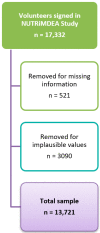Lifestyle and Health-Related Quality of Life Relationships Concerning Metabolic Disease Phenotypes on the Nutrimdea Online Cohort
- PMID: 36613089
- PMCID: PMC9819172
- DOI: 10.3390/ijerph20010767
Lifestyle and Health-Related Quality of Life Relationships Concerning Metabolic Disease Phenotypes on the Nutrimdea Online Cohort
Abstract
Obesity, diabetes and cardiovascular events are non-communicable diseases (NCDs) directly related to lifestyle and life quality. Rises on NCDs rates are leading to increases in early deaths concerning metabolic morbidities. Health-related quality of life (HRQoL) has been described as a subjective perception about the influence of health and personal features on human well-being. This study aimed to characterize phenotypic and lifestyle roles on the occurrence of metabolic diseases and determine the potential mutual interactions and with HRQoL. Data from an online adult population (NUTRiMDEA study, n = 17,332) were used to estimate an adapted Obesogenic Score (ObS), while logistic regression analyses were fitted in order to examine relevant factors related to the prevalence of different metabolic diseases including HRQoL. Sex and age showed significant differences depending on lifestyle and metabolic health (p < 0.05). Adherence to the Mediterranean diet and physical activity showed a mutual interaction concerning ObS (p < 0.001), as well with metabolic health (p = 0.044). Furthermore, metabolic diseases showed own features related to sociodemographic and lifestyle characteristics in this population. Metabolic syndrome components may be differently influenced by diverse lifestyle or socioeconomic factors which in turn affect the perceived HRQoL. These outcomes should be taken into account individually for a precision medicine and public health purposes.
Keywords: Mediterranean diet; health-related quality of life; metabolic health and disease; online data collection; physical activity.
Conflict of interest statement
The authors declare no conflict of interest.
Figures



Similar articles
-
Cardiometabolic Health Status, Ethnicity and Health-Related Quality of Life (HRQoL) Disparities in an Adult Population: NutrIMDEA Observational Web-Based Study.Int J Environ Res Public Health. 2022 Mar 3;19(5):2948. doi: 10.3390/ijerph19052948. Int J Environ Res Public Health. 2022. PMID: 35270641 Free PMC article.
-
Comparison of Seven Healthy Lifestyle Scores Cardiometabolic Health: Age, Sex, and Lifestyle Interactions in the NutrIMDEA Web-Based Study.J Epidemiol Glob Health. 2023 Dec;13(4):653-663. doi: 10.1007/s44197-023-00140-1. Epub 2023 Aug 27. J Epidemiol Glob Health. 2023. PMID: 37634195 Free PMC article.
-
Lower educational level and unemployment increase the impact of cardiometabolic conditions on the quality of life: results of a population-based study in South Australia.Qual Life Res. 2017 Jun;26(6):1521-1530. doi: 10.1007/s11136-017-1503-y. Epub 2017 Feb 11. Qual Life Res. 2017. PMID: 28190132
-
Offspring body size and metabolic profile - effects of lifestyle intervention in obese pregnant women.Dan Med J. 2014 Jul;61(7):B4893. Dan Med J. 2014. PMID: 25123127 Review.
-
Epidemiology and treatment of the metabolic syndrome.Ann Med. 2004;36(5):332-46. doi: 10.1080/07853890410031849. Ann Med. 2004. PMID: 15478308 Review.
Cited by
-
Reciprocal and Differential Influences of Mediterranean Diet and Physical Activity on Adiposity in a Cohort of Young and Older than 40 Years Adults.Nutrients. 2024 Jun 5;16(11):1777. doi: 10.3390/nu16111777. Nutrients. 2024. PMID: 38892710 Free PMC article.
-
Nutritional and Lifestyle Features in a Mediterranean Cohort: An Epidemiological Instrument for Categorizing Metabotypes Based on a Computational Algorithm.Medicina (Kaunas). 2024 Apr 8;60(4):610. doi: 10.3390/medicina60040610. Medicina (Kaunas). 2024. PMID: 38674256 Free PMC article.
-
Visceral fat, cardiovascular risk factors and quality of life in lupus activity categorised via complement C3.Lupus Sci Med. 2025 May 14;12(1):e001423. doi: 10.1136/lupus-2024-001423. Lupus Sci Med. 2025. PMID: 40374236 Free PMC article.
-
Computational algorithm based on health and lifestyle traits to categorize lifemetabotypes in the NUTRiMDEA cohort.Sci Rep. 2024 Oct 22;14(1):24835. doi: 10.1038/s41598-024-75110-z. Sci Rep. 2024. PMID: 39438551 Free PMC article.
-
Comparison of Metabolic Syndrome, Autoimmune and Viral Distinctive Inflammatory Related Conditions as Affected by Body Mass Index.J Clin Med. 2024 Oct 22;13(21):6298. doi: 10.3390/jcm13216298. J Clin Med. 2024. PMID: 39518437 Free PMC article.
References
-
- Bennett J.E., Stevens G.A., Mathers C.D., Bonita R., Rehm J., Kruk M.E., Riley L.M., Dain K., Kengne A.P., Chalkidou K., et al. NCD Countdown 2030: Worldwide trends in non-communicable disease mortality and progress towards Sustainable Development Goal target 3.4. Lancet. 2018;392:1072–1088. doi: 10.1016/S0140-6736(18)31992-5. - DOI - PubMed
-
- World Health Organization The Top 10 Causes of Death. [(accessed on 19 June 2022)]. Available online: https://www.who.int/news-room/fact-sheets/detail/the-top-10-causes-of-death.
-
- Roth G.A., Abate D., Abate K.H., Abay S.M., Abbafati C., Abbasi N., Abbastabar H., Abd-Allah F., Abdela J., Abdelalim A., et al. Global, regional, and national age-sex-specific mortality for 282 causes of death in 195 countries and territories, 1980–2017: A systematic analysis for the Global Burden of Disease Study 2017. Lancet. 2018;392:1736–1788. doi: 10.1016/S0140-6736(18)32203-7. - DOI - PMC - PubMed
-
- Budreviciute A., Damiati S., Sabir D.K., Onder K., Schuller-Goetzburg P., Plakys G., Katileviciute A., Khoja S., Kodzius R. Management and Prevention Strategies for Non-communicable Diseases (NCDs) and Their Risk Factors. Front. Public Health. 2020;8:574111. doi: 10.3389/fpubh.2020.574111. - DOI - PMC - PubMed
Publication types
MeSH terms
LinkOut - more resources
Full Text Sources
Medical

